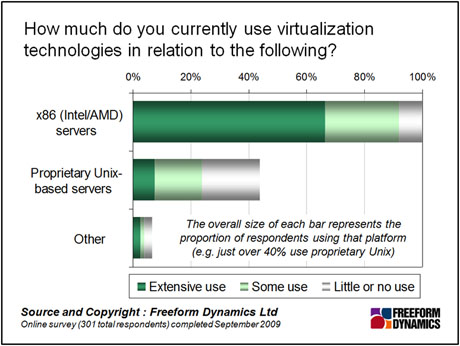Respondents have told us that the virtualisation of significant portions of your x86 server estates are major project areas in which you plan to invest both money and, much more importantly, your time.
This is all well and good, but as everyone in IT understands, x86 servers are not the only platforms in town. So what is happening with other server platforms and virtualisation?
Last August we asked you just this question in a mini-survey. The results, as shown in the figure below, make for interesting reading, especially when considering the length of time that the different platforms have been utilised to host essential business applications.

As the figure points out, almost every organisation deploys x86 platforms, and a growing proportion of these servers are already making significant use of virtualisation technologies. It is worthwhile remembering that it is only comparatively recently that organisations have given x86 platforms equal prominence and trust with well established Unix, mainframe and other systems for the hosting of essential business services.
With this in mind it is fascinating to see that the uptake of virtualisation in Unix and other non-x86 systems is lower than in the currently very fashionable x86 space. In order to make sense of the data it is essential to note first that fewer than half of those surveyed actually make use of UNIX systems, meaning that around half of users are utilising the virtualisation facilities on offer on UNIX servers – which is still quite a big number.
We should also remember that the poll results were self-selecting – that is, respondents would tend to have an interest in virtualisation – so the results only really make sense when compared against each other, rather in absolute terms. For example, while the figure above indicates extensive use of virtualisation on x86 servers, we know that in reality the actual percentage of all such systems that run virtualisation software is still way below the halfway mark.
Another factor to bear in mind is that while UNIX platforms have long enjoyed the ability to use a variety of hardware and software based partitioning and virtualisation capabilities, a large number of such servers only run one application, as shown on the chart below. This is especially the case in small and mid-sized organisations where the majority of applications are hosted on Windows machines with perhaps only one or two applications running on UNIX. Far fewer traditional UNIX servers have been the subject of server consolidation projects than has been the case for x86 systems.
The fact that take-up is still nowhere near all pervasive is perhaps is not so unusual despite the major UNIX systems, mainframes and other business servers having had the ability to use virtualisation solutions for a long time, certainly far longer than on x86. However, it is still my opinion that the vendors of UNIX systems have not done a particularly good job of highlighting what virtualisation offerings their systems support, and the potential benefits that using such tools can provide.


Have You Read This?
Generative AI Checkpoint
From Barcode Scanning to Smart Data Capture
Beyond the Barcode: Smart Data Capture
The Evolving Role of Converged Infrastructure in Modern IT
Evaluating the Potential of Hyper-Converged Storage
Kubernetes as an enterprise multi-cloud enabler
A CX perspective on the Contact Centre
Automation of SAP Master Data Management